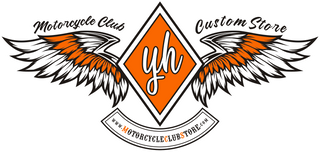Motorcycle clubs are more than just groups of individuals who share a love for riding; they embody a culture, a community, and a way of life. At the heart of every club lies a unique emblem—often adorned on vests, jackets, and merchandise—that tells a story. These badges are not just decorative; they are a reflection of the club's identity, values, and history. In this blog, we delve into the significance of motorcycle club emblems, exploring their design, symbolism, and the stories they carry.
The Origins of Motorcycle Club Emblems
Motorcycle clubs began to emerge in the early 20th century, primarily in the United States, as returning soldiers sought camaraderie and freedom on two wheels. As these clubs formed, members quickly realized the need for a way to identify themselves and their allegiance to the group. Thus, emblems began to take shape, often influenced by military insignias, tribal symbols, and regional pride.
The design of a motorcycle club emblem often incorporates various elements, such as animals, weapons, or religious symbols, each carrying its own meaning. For instance, a skull might represent fearlessness and a rebellious spirit, while a wolf could symbolize loyalty and teamwork. Each emblem acts as a badge of honor, representing the shared experiences and values of the club members.
Design Elements and Their Meanings
A typical motorcycle club emblem includes several key components:
1.Club Name: The name of the motorcycle club is usually prominently displayed, serving as a direct identifier. This name often reflects the club's origins, location, or mission.
2.Location: Many emblems include a geographical identifier, such as the city or state where the club was founded. This not only helps in establishing a sense of local pride but also indicates the club's roots and history.
3.Symbols: Emblems often feature distinct symbols that convey the club's ethos. For instance, a cross might signify faith, while flames could represent the thrill of speed. These symbols are carefully chosen to resonate with the members and their shared beliefs.
4.Colors: The colors used in the emblem also play a significant role. Black and white are common, representing unity and strength, while other colors may have specific meanings based on the club's culture or location. For instance, red might symbolize courage, while blue could represent loyalty.
5.Motto: Some emblems include a motto or slogan that encapsulates the club's philosophy. This phrase serves as a guiding principle for members, reinforcing their commitment to the club and its values.
Personal Stories Behind the Emblems
Every emblem carries stories of the individuals who created it and the experiences that shaped the club. For example, the emblem of a prominent motorcycle club may feature an eagle, symbolizing freedom. This choice could be rooted in the founders' belief in liberty and the thrill of the open road. Each stitch and color choice in the emblem tells a tale of brotherhood, adventure, and sometimes, hardship.
Consider the case of a club that emerged from a close-knit community. Its emblem might showcase a local landmark, reflecting the members' pride in their heritage. The design could stem from a shared experience—a ride that united them after a tragedy or a charity event that brought joy to their town. These stories are what breathe life into the emblem, transforming it from a mere design into a cherished symbol of unity.
The Role of Emblems in Brotherhood
In the motorcycle community, an emblem represents more than just a logo; it embodies a bond that is often likened to family. When a new member is initiated into a club, the presentation of their emblem serves as a rite of passage. It signifies their acceptance into the group, binding them to a network of like-minded individuals who share a passion for riding and adventure.
The emblem fosters a sense of belonging, encouraging members to uphold the values and traditions of the club. It becomes a source of pride, with members donning their insignia during rides, events, and gatherings. The act of wearing the emblem not only celebrates individual identity but also reinforces the collective spirit of the club.
Challenges and Controversies
While motorcycle club emblems serve as powerful symbols of camaraderie, they can also attract controversy. Some emblems are associated with specific lifestyles or subcultures that may be viewed unfavorably by the broader society. The use of certain symbols can lead to misunderstandings, and clubs may face scrutiny or stigma based on their insignia.
Furthermore, rivalries between clubs can intensify the significance of emblems. Conflicts over territory or ideology can lead to tensions, and emblems may become points of contention. Despite these challenges, many clubs continue to uphold their values of brotherhood and respect, using their emblems to foster unity within their ranks.
Conclusion: The Lasting Legacy of Motorcycle Club Emblems
Motorcycle club emblems encapsulate rich histories, personal stories, and the essence of brotherhood. They serve as reminders of the journeys taken, the challenges faced, and the friendships forged along the way. As motorcycle culture continues to evolve, these emblems remain steadfast symbols of loyalty, identity, and passion.
For anyone involved in the motorcycle community, whether as a member of a club or an enthusiast, understanding the significance behind these emblems can deepen appreciation for the culture and its values. The next time you see a motorcycle club emblem, take a moment to reflect on the story it tells—a story of freedom, adventure, and the unbreakable bonds of brotherhood.
